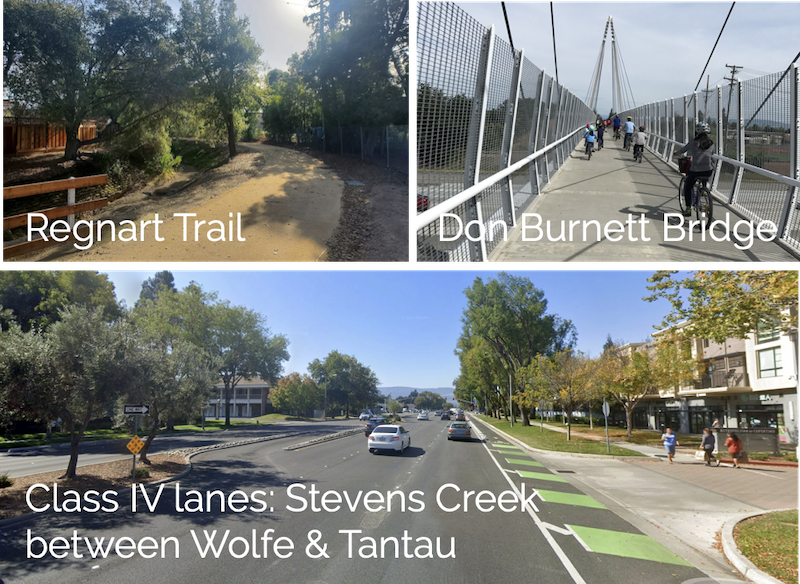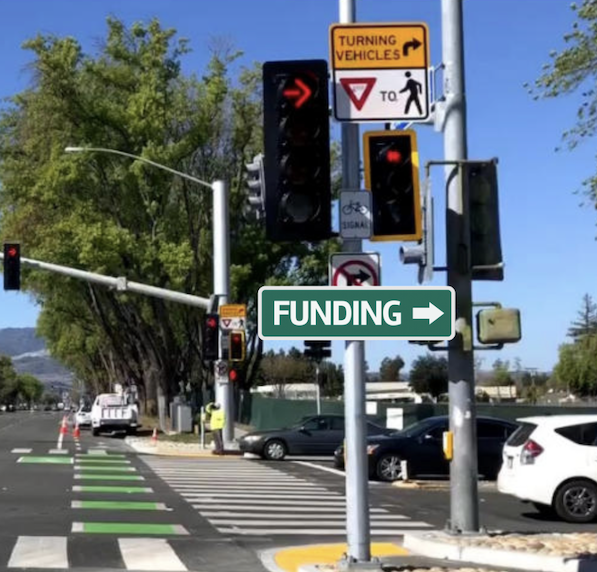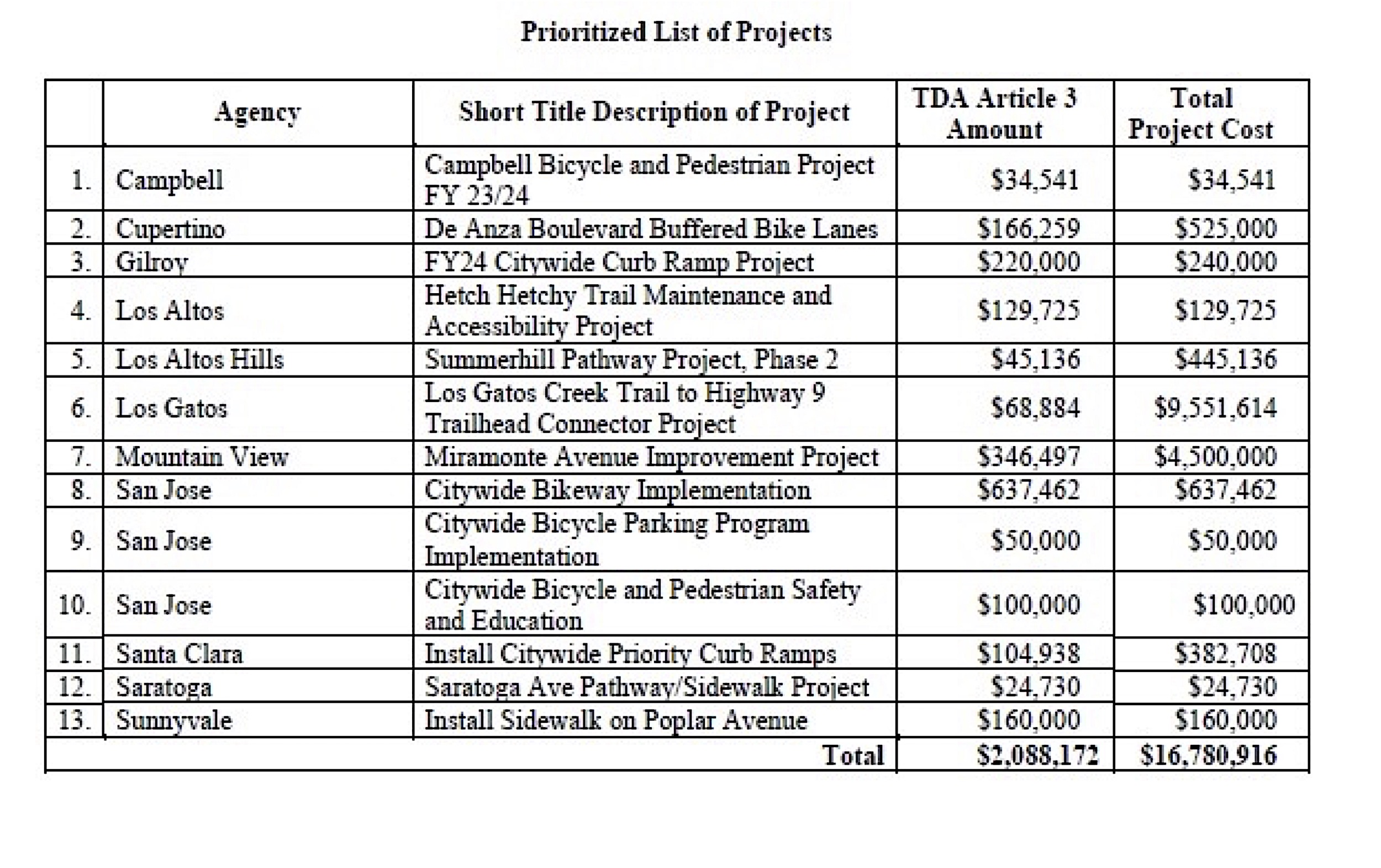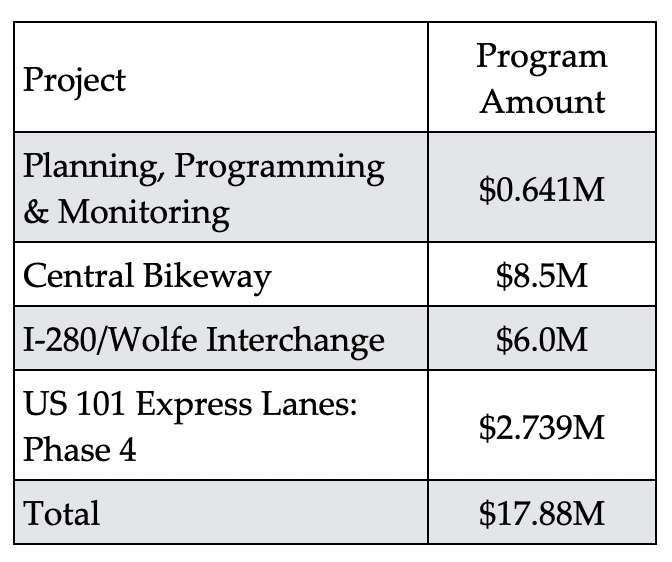Grant funding is a key way for a city to pay for bike and pedestrian infrastructure projects. Because Cupertino is facing an unprecedented budget crisis right now, it is even more important that it takes advantage of these grant opportunities. Instead, most of the grant money is going to other cities. This is for a variety of reasons.
Funds are available…but Cupertino misses out
There are many sources of grant funding: local, state, and federal, public, and private.
Below are some of the sources of funding that Cupertino has received a portion of this year, or would qualify for as a future recipient.


Some Cupertino projects paid for by grant money received in years past.
- The State of California’s Transportation Development Act (TDA) funds, which are derived from a ¼-cent of the State’s general sales tax.
- The California State Transportation Improvement Program (STIP) is a rolling five-year program of transportation projects funded by revenues distributed by the State of California. Funds are directed to Caltrans and Regional Transportation Planning Agencies.
- The TFCA CPM (Transportation Fund for Clean Air County Program Manager) grant program
- The Metropolitan Transportation Commission (MTC) One Bay Area Grant (OBAG) and Active Transportation Program (ATP) awards
The TFCA CPM grant program was actually undersubscribed – in other words, fewer requests for funding were received than the pool of money available – but Cupertino still did not receive any grant funding. It’s unknown if Cupertino applied for any grant funding from this program. Cupertino also did not receive any funding from the MTC One Bay Area Grant (OBAG) and Active Transportation Awards, though San Jose received $62.34 million dollars.
It’s no surprise that San Jose receives a large part of local funding: they have by far the largest population in their city and they can make compelling equity arguments for projects in more disadvantaged areas of the city.
Recent grants Cupertino was successful in receiving
During the last round of grant approvals of the state of California’s Transportation Development Act (TDA) funds, Cupertino received $160K for DeAnza buffered bike lanes – about 30% of the total cost of the project. These lanes will enhance the existing single painted stripe bike lanes (“Class II”) between Bollinger Road and Homestead Road by adding a painted buffer zone to separate car traffic from bike traffic.
The city also received $6M for 2024 from STIP for the I-280/Wolfe interchange. While this money doesn’t go directly to the city of Cupertino, it benefits the city since that intersection is within our city limits.
The Public Works Department has also been awarded a $3.2 million Highway Safety Improvement Program grant to make safety improvements along 15 roadway corridors in the city. These corridors include segments of De Anza Boulevard; Homestead, Wolfe, Bollinger, McClellan, Stelling and Bubb roads; Mariani, Mary, Tantau, Miller and Blaney avenues; and Rainbow, Valley Green and Calvert drives.
If Cupertino could receive more of this funding, it could make a huge impact on our ability to meet our climate action, transportation, and connected neighborhoods goals.
Many projects in Cupertino have been funded by grant money, including the Regnart Creek Trail, the Don Burnett (Mary) Bridge, much of the McClellan protected bike lanes, and the Tamien Innu (I-280 trail) central and eastern portions. Apple funding (private grant funding) has covered many other projects, including Mary Ave lanes, Stevens Creek protected lanes from Tantau to Wolfe, and design costs for the Tamien Innu.
Stalled Cupertino projects that could benefit from grants
There are many projects in Cupertino that could benefit from grant funding but have been languishing for years or shelved before they are even started, despite strong resident support:
- The Carmen Bridge to create a safe route to school for hundreds of students at Stevens Creek Elementary, Kennedy Middle School, and Monta Vista High School
- A tunnel or a bridge connecting the Linda Vista trail to McClellan Ranch to improve pedestrian safety
- Completing the protected bike lanes on Stevens Creek Boulevard to Foothill Blvd
- Improved intersections near schools such as Imperial & McClellan near Lincoln Elementary
What’s holding Cupertino back from more funding
A combination of factors is causing Cupertino to miss out on millions in grant funding.
Lack of a grant writer
One major one is that we do not have a dedicated, professional grant writer. Though a grant writer adds to personnel expenses, a city can easily make up that amount by receiving grants. Most local grant writers generate 5-10x the funding for their city than they cost the city in salary. Unfortunately, with the headcount freeze in Cupertino, coupled with a non-replacement of headcount policy, hiring a grant writer is not currently planned.

Shortage of staff and city funds
Most grant funding organizations require that the project has already been approved for construction and the city has designated funds out of their own city budget to build the project before they will give grant money. It can be a difficult decision to approve a project in the hope that grant funding will come through to cover the costs. The project will also need to have completed feasibility and design to get to that point. These require staff resources and carry a small cost (though there is grant funding available for design as well).
Once a project receives grant funds, the grant funding organization requires the city to start work on the project within a reasonable period of time such as six months to a year. It can be a problem for cities with limited resources to be able to commit that they will start the project within the required timeframe.
Cupertino’s severely short-staffed city team, combined with the city’s severe budget crunch, make it difficult to allocate the staffing and funding needed to move projects to approval stage or commit to getting the projects completed if grants are received.
Lower equity points on grant prioritization formulas
Most grant-giving organizations assign points to projects based on a number of criteria to be able to prioritize them. One important criteria is equity. Many cities with a greater proportion of disadvantaged residents, like San Jose and Oakland, score higher on the equity points, and win more grant funding as a result.
How do we unlock more grant funds?
To get more grant funding, more and better applications will need to be written. This requires a dedicated, professional grant writer, which can be a consulting grant-writing firm or an in-house grant writer. In-house grant writers tend to be much more successful in obtaining grant money for their cities, as they understand the local area much better and are more integrated into the city staff.
An in-house grant writer seems impossible to hire currently given the city’s budget constraints but it may actually be a very cost-effective investment. An in-house grant writer would bring in millions in funds, far more than the cost of that person’s salary. Those millions could then free up some of the budget currently allocated to existing projects, creating possibilities for funding more staff and more city priorities. It’s a potential source of revenue that is surprisingly efficient and ongoing. It should be prioritized in the current city discussions about new sources of revenue.
Do you agree or disagree with our assessment? Let us know in the comments below. We look forward to the discussion!
The information in this article is solely the opinion of the author and Walk-Bike Cupertino and does not reflect the opinions of any other organization or entity. For more information, contact WBC at info@walkbikecupertino.org.



It seems an excellent idea for the city to hire a grant writer. Since this position statistically could generate 10x the cost of the position, there should be an exception made for the “no increase in headcount” position by the city. Hiring of positions that would generate income should be exempt from our city’s hiring freeze.